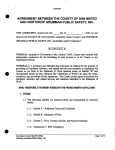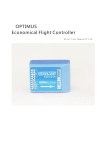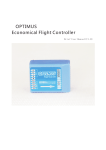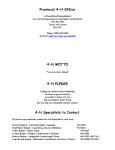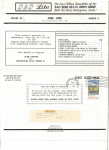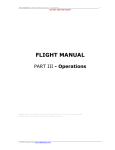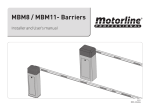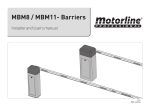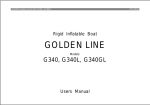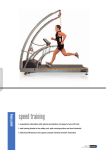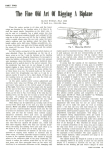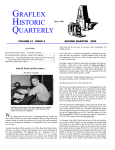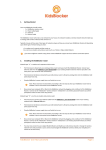Download PDF Manual - Macca`s Vintage Aerodrome
Transcript
Douglas World Cruiser 1924 Around the World United States Assembly Manual for ARF stand-off scale model in 1:5 scale. Historical data and presentation. Model design and drawing by K&W Model Airplanes Inc. © USER'S MANUAL Douglas World Cruiser ARF 1 Douglas World Cruiser Originals Douglas World Cruiser ARF 2 The Douglas World Cruiser Donald Douglas started manufacturing airplanes in January 1920, when he left chilly Cleveland for balmy California, determined to make it on his own. He had only $600 and a family to support. Fortunately, he found financial backing from wealthy David R. Davis, who had $40,000 to back an aircraft manufacturing company, provided it built an airplane that would make the first nonstop, coast-to-coast flight. The Davis-Douglas Company set up shop first in the back room of a Pico Boulevard barber shop and then in a 3,600-square-foot loft above a Los Angeles planing mill. Helped by a staff of five former employees of the Glenn Martin Company, Douglas designed and built the Cloudster which first flew Feb. 24, 1921. In June 1921, the Cloudster set out for its flight from March Field, California, to Curtiss Field, New York, but engine trouble forced it to make an emergency landing in Texas, and it was flown back to March Field for installation of an improved engine. By then, Douglas had landed a contract to build torpedo bombers for the Navy, starting with the DT-1 (Douglas torpedo, first), followed by the DT-2 production version. The DT-2 was redesigned as the basis for the Douglas World Cruiser (DWC) and was selected as part of a secret military project to build the first airplane to circumnavigate the globe. The DWC had a modified fuel system, extra struts and a differently shaped vertical tail service than the DT. Douglas built five DWCs for the Aviation Service of the U.S. Army. Four of the planes, the Seattle, the Boston, the Chicago and the New Orleans, left Santa Monica, Calif., for Seattle, March 17, 1924, and left Seattle April 4. The Seattle was lost during a Pacific storm over Dutch Harbor, Alaska. The Boston made a forced landing in the mid-Atlantic. The other two DWCs were kept flying with the help of 15 extra engines, 14 extra sets of floats and duplicates of all the airframe parts, stashed at various sites around the world. The Chicago and New Orleans circled the globe and returned to Seattle Sept. 28, 1924. They flew 27,553 miles in six months and six days and earned the company its motto “First Around the World - First the World Around.” The fifth DWC was tested and delivered to the Army Air Service for test and approval. It was later renamed Boston II and used to replace the first Boston, and with the first Boston’s crew, completed the flight around the world. The Historic Flight Around the World With the successful crossings of the Atlantic in 1919 by the U.S. Navy’s NC-4 and the British flyers, Alcock and Brown, in a Vickers Vimy, the ambition to circumnavigate the globe by airplane was a natural next challenge. The British made an unsuccessful attempt in 1922. The following year a French team tried and failed, and another British effort was being organized, but was abandoned. The Italians and Portuguese were also discussing plans for a round-the-world flight at this time. In July of 1923, United States War Department disclosed that it was sending two officers on an information-gathering trip to stake out a route for a global flight to be attempted by the U.S. Army Air Service in 1924. Maj. Gen. Mason M. Patrick, Chief of the Air Service, was put in charge of planning and directing the flight. For the flight, the Air Service commissioned specially-built aircraft from the Douglas Aircraft Company in Santa Monica, California. The design was a sturdy, 15-m (49-ft) span, two-place biplane powered by a single twelve-cylinder, water-cooled 400-horsepower Liberty Engine. A total of five airplanes were built, including a prototype for testing. The Douglas World Cruisers, as they were named, could be equipped with wheels or pontoons, depending on the terrain from which they were operating. The aircraft did not have radios or advanced navigational aids, only the standard rudimentary flight instrumentation of the day. The four World Cruisers built for the round-the-world attempt were christened the Seattle, the Chicago, the Boston, and the New Orleans, to represent the regions of the United States. Four of the Air Service’s top pilots were selected. Major Frederick L. Martin was designated overall flight commander and flew the Seattle. Lt. Lowell H. Smith, Lt. Leigh Wade, and Lt. Erik H. Nelson piloted the Chicago, the Boston, and the New Orleans respectively. Each pilot was permitted to select his own mechanic/co-pilot. The crews trained at Langley Field in Virginia in navigation and meteorology, and practiced with the prototype airDouglas World Cruiser ARF 3 The four World Cruisers built for the roundthe-world attempt were christened the Seattle, the Chicago, the Boston, and the New Orleans, to represent the regions of the United States. Four of the Air Service’s top pilots were selected. Major Frederick L. Martin was designated overall flight commander and flew the Seattle. Lt. Lowell H. Smith, Lt. Leigh Wade, and Lt. Erik H. Nelson piloted the Chicago, the Boston, and the New Orleans respectively. Each pilot was permitted to select his own mechanic/co-pilot. The crews trained at Langley Field in Virginia in navigation and meteorology, and practiced with the prototype airplane while the flight aircraft were being constructed and prepared. In the meantime, elaborate preparations were being made for fueling and repair sites at strategic locations along the route, arranging of overflight and landing clearances, and securing the cooperation of the U.S. Navy and the Royal Air Force. Because the United States did not recognize the Soviet Union at this time, flying over Siberia was prohibited, necessitating a southeast Asian route that added 11,000 km (6,875 mi) to the journey. After practice with the four flight aircraft in Santa Monica and San Diego, the crews headed north to Seattle, the official point of departure for the round-the-world flight. Shortly after setting off on the first leg of the trip on April 6, 1924, Major Martin, piloting the lead airplane, the Seattle, fell behind. Engine trouble forced him down and the other World Cruisers continued on. After an engine replacement, Martin and his mechanic, Sgt. Alva Harvey, attempting to catch up with the others waiting at Dutch Harbor, Alaska, departed in questionable weather. The Seattle crashed into a mountainside after getting lost in fog. The airplane was destroyed, but luckily Martin and Harvey escaped with minor injuries. Lt. Smith, piloting the Chicago, took over as flight commander. Much of the rest of the trip passed with relative good fortune. The three remaining World Cruisers continued on via the northern Pacific chain of islands en route to Japan. The three aircraft then traversed China, Indo-China, Siam (Thailand), Burma, India, Persia, Asia Minor, the Balkans, and France. From Strasbourg, they were escorted to Paris by the French Air Force, and there they received a tumultuous welcome from cheering crowds on July 14, Bastille Day. The next day they left Paris and landed in London. Douglas World Cruiser ARF 4 Disaster occurred again, however, over the north Atlantic between the Orkney and Faroe islands, when the Boston suddenly lost oil pressure and had to alight in the ocean. Although the landing was successful, the Boston was damaged beyond repair during an attempt to hoist it on board a Navy ship. The World Cruiser fleet was thus reduced to two, but at Pictou, Nova Scotia, the prototype aircraft arrived to join the remaining two and became the Boston II. From there the planes flew on for a triumphal journey across the United States, arriving in Seattle on September 28. The 44,085 km (27,553 mi) flight was completed in 175 days-a flying time of 371 hours 11 minutes-with an average speed of 112 kph (70 mph). The 1924 round-the-world flight remains one of the truly great achievements in aviation. It was an incredibly arduous trek. The loss of two of the airplanes and the close call for Major Martin and Sgt. Harvey in the crash of the Seattle were hardly the only setbacks. Throughout the journey the crews prevailed against an endless series of forced landings, repairs, bad weather, and other mishaps that continually threatened the success of the flight. Further, it was a monumental logistical accomplishment. More than just an aviation milestone, the flight was an important step toward the goal of world-wide air transport in the decades to come. Two weeks before the Douglas World Cruisers completed their flight around the world, a young museum aide named Paul E. Garber recommended that the Smithsonian Institution should acquire one of the aircraft for its collection. Eleven months later, the Secretary of War approved the transfer of the Chicago to the Smithsonian. On September 25, 1925, this aircraft made its final flight from McCook Field in Dayton, Ohio, to Bolling Field in Washington, D.C. Later that fall, the airplane was placed on public display in the Smithsonian’s Arts and Industries building. The Chicago was restored in 1971-1974 and moved into the new National Air and Space Museum building in 1976. Of the five Douglas World Cruisers built, the New Orleans is the only other survivor. It is in the collection of the Los Angeles County Museum of Natural History and was on display at the United States Air Force Museum from 1957 to 1988, and subsequently at the Museum of Flying in Snata Monica, California. Engine and Radio installation Note: Remove top wing section from the cabane and remove all aluminum panels First remove the aluminum cowl by unscrewing the 2mm machine screws holding the cowl to the engine bay.Remove the dummy engine by unscrewing it from the motor mounts.Refer to pictures below Screws Motor Mount Screws Mount Tank and Throttle Servo here. Radio & Sevo Installation Remove the aluminum panelling around the cockpit by removing the 2mm screws. This will give you access to the servo locations. We recommend flying this aircraft with at least a 1.80 , four stroke engine. The engine can be readily mounted in the engine bay. You will have to remove a portion of the dummy engine to allow for the cylinder head cooling. The tank and throttle servo can be mounted behind the engine. Yor will have to make a small servo support for the throttle servo out of scrap wood. If you decide to use a gas engine, you will have to make a suitable motor mount. The gas engine can be mounted upside down quite readily. The pictures below show the engine bay covered and uncovered. The entire aluminum covering can be removed so that you can readily modify the engine mounts as required. Mount the Elevator rudder servos in the spaces provided. Connect the servo arms to the control stick and rudder bar with short pieces of music wire with threaded ball links on either end. Install ball links on the control column and rudder bar as required. The picture below shows the location of the control stick and the rudder bar in the servo/radio receiver bays. The battery pack can be mounted anywhere in this bay, with the switch mounted on the cockpit formers. Be sure to fasten the battery pack securely. Picture of Servo bay, the cocpit and bottom covering has been removed. Rudder bar Control stick Douglas World Cruiser ARF 5 Place Sevos in this cutout Connect them to the rudder bar and the control column with rods and ball links Tail Group Assembly The tail group is designed to easily disassembled for transport. The horizontal stabilizer is held to the fuselage with three Nylon Screws. Nylon Screws Horizontal Stabilizer supports 2. Install the upper wing halves in the same manner. Wing is attached to the center Cabane. 3. Fasten the tie straps on the upper and lower wings with the screws provided. 3. Install the interplane wing struts. The struts are packaged in marked plastic bags. It is recommended that you mark them individually after installation for ease of disassembly. Connect the strut cross bracing by clipping the kwick links in place. 4. Attach the landing and flying wires according to the sketch below and on the last page of this manual. The wires have all been precut and the plane was completely rigged at the factory. So each wire should be at the correct length for attachment.. 5. Install the aileron interplane connecting rods. 6. Install the Airleron servos in the wells provided in the top wing. There is a tube preinstalled int the cabane strut. Feed a piece of servo wire through this tube and install connectors on both ends. These connectors will then connect to the aileron servo and the radio in the fuselage. Connect the aileron push rods to the servo and check the throw of the ailerons (20° up and down). For ease in control you may adjust the servo arms to give differential throw in which case the up deflection should be 30°. Servo Access bay Vertical Stabilizer supports Landing and Flying wires Dowel Bracket The Vertical Stabilizer is held with a dowel at the leading edge and a double L bracket at the trailing edge. The rudder is fixed with hinge points that are glued into the rudder and held with screws in the vertical stabilizer. Inter Plane Struts Wing Rods Assembly of wing panels Refer to pictures on the Right 1. Install the lower wings by aligning the rods with the holes in the wing and inserting fully. Douglas World Cruiser ARF 6 Pre Rogged Landing wires Access through the rear cockpit Wing Rods Aileron control Rod tube Lower Wing Rods Joint Landing gearAssembly Push the landing gear supports in the holes in the fuselage. Secure with the straps and screws provided. Wing connecting straps Anchors for Flying wires Install the Gear supports to the lower wing. seat securely in the holes provided and install the retainer straps. The end of the lower strut is the axel for the wheel. The axel is fed through the slot in the support bracket and retained with a Bungie (rubber bands) cord. See the sketch below for guidance in installing the bungie cord. This is a very efficient shock absorber. Upper Gear Support Wing connecting straps and anchor for flying wires Lower Gear Support Bungie Fuselage Assembly The Fuselage is designed to be separated Screws behind the r e a r cockpit. T h e Fuselage is shipped in t h e disassembled state. Too assemble, align the t w o Alignment Dowels Brackets Cutaway view of the landing gear supports Douglas World Cruiser ARF 7 Install Bungie cord The axels are sprung by using bungie (rubber bands) cords. The combination of the bungie cord and the spring steel in the support that terminates in the wheel axel supply adeqate shock absorption upon landing. The method of lacing the bungie is depicted below. aircraft is limited aerobatic like all biplanes from WW 1. Remember that all turns are made using rudder and elevator and compensated with aileron! The landing approach can be rather steep as per prototype but the flare out needs almost full up elevator. Once on the ground keep the tail down to maintain directional stability. In case you have to make a dead stick landing, keep the nose down and the speed up. The wires produce a lot of drag! It is always better to do a good landing in a bad place than vice versa... Happy Landings! Lacing of bungeerubber for the wheel shaft Balancing The C/G (center of gravity) or balancing point should be no further back than approx. 14 cm (5½”) measured from the center of the leading edge on the upper wing. Make adjustments by adding wheight if necessary. The allowable range of the CG is around +/- 2 cm. The plane will be controllable and stable within this range. Flying Let the engine swing a 14"x6" propeller if possible. This gives better thrust outside the big radiator front and reduces sound to a more realistic level. Flying characteristic is that of a biplane from the WW-I period and it will fly happily on 3/4 throttle. Ground handling on a hard surface demands a gentle hand but on grass surface, the tailskid provides enough directional stability. During the initial take off run first keep full up elevator to keep the tail down. As the speed builds up, let go gradually of the up elevator and the tail comes up. You have to compensate for the torque with right rudder but as the speed builds up the rudder is returned to neutral. This model should fly of the ground and not be pulled. Unlike many other planes from this period this type has a lifting profile stabilizer that in theory should offset the climbing tendency of the high lift wing profile. Once airborn the Douglas World Cruiser ARF 8 Douglas World Cruiser ARF 9 What is in the box: wires are supplied in the correct lengths and need only to be clipped to their positions. The ARF kit contains the parts shown in the picture. All the parts are covered and painted. All the rigging 12 8 8 9 9 11 3 1 5 4 7 6 10 2 11 10 1. Fuselage with wing cabane, detachable landing gear. 2. Scale wheels 3. Dummy Engine 4. Scale propeller 5. Fin / rudder 6. Tail skid. 7. Stabilizer / elevator 8. Upper wing panels 6 9. Lower wing panels 10. Interplane struts 11. Wires, turnbuckles and hardware 12. Assembly manual Rigging Details 1. All rigging wires are precut to length with quick links attached. 2. Connect cross brace wires, colored Blue in photo. 3. Connect Flying Wires, colored Black in photo. 4. Connect Landing Wires, Colored Red in photo. 3 4 Douglas World Cruiser ARF 10 2 Assembly Manual for ARF stand-off scale model in 1:5 scale. Historical data and presentation. Model design and drawing by K&W Model Airplanes Inc. © P.O.Box 1229, Cebu City Centrl. Postoffice Cebu City 6000, Philippines Visiting address: 3343 Gun-Ob, Kinalumsan, Lapu-Lapu City 6015, PHILIPPINES Phone +63 32-340 0772, Cellular +63 917-3200 985 Telefax +63 32-340 7131, E-mail: [email protected] Website http://www.kwmairpl.com.ph Douglas World Cruiser ARF 11














